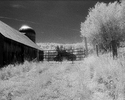I develop two 120 rolls in a single reel frequently.
I use the AP manufactured reels that are compatible with Paterson tanks. They are the ones sold as "Arista Premium" by Freestyle Photographic.
If you use the swizzle stick for agitation for anything but the first seconds of development, you are not following Paterson's directions, and you are greatly increasing both the chances of uneven development and the likelihood that the films will travel within the channels of the reel.
I previously experimented with rotary agitation and the Paterson tanks, and found that if I used rotary agitation for anything more than the first 30 seconds of development, two rolls would inevitably move in the reels, and usually overlap.
I don't bother with the tape - I can't reliably attach it anyways.
I use R. Gould's method of loading the two rolls.
One thing I do that nobody has mentioned so far is that I pre-soak the film for three minutes before development. I've learned that when the film is in water, stop bath or fixer, it is much less likely to move around than when it is in developer - it is slipperier (?) in developer!
So what I do is:
1) load the reels with two rolls as mentioned, without using tape to attach the films;
2) pre-soak the film in room temperature tap water for three minutes, using continuous rotary agitation;
3) develop the film in room temperature replenished X-Tol, using rotary agitation for the first 30 seconds, and inversion agitation using the Kodak system (5 seconds every 30 seconds) for the balance of the development time;
4) put the film through the stop bath, fixer, rinse and HCA steps using continuous rotary agitation.
The result: no film overlap.
I think (but cannot prove) that the reason that this works is due to the pre-soak. I think (OK, I remember) that film introduced dry into developer is very, very slippery. Whereas, after three minutes in tap water, film isn't nearly as slippery, even after it is transferred to developer.
I expect that this benefit is at least partially related to the ph of the rinse water - most tap water is at least slightly acidic.
However, there is at least a possibility that some of the benefit might be related to differences between the Paterson reels and the AP compatible reels.
I would suggest to the OP that he/she try the pre-soak and inversion agitation during development, to see if that resolves his problems.






